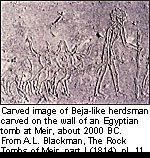Cranial remains [unspecified date, but guessing by some references to the burial site in that same area, it is perhaps dated to ca. A.D. 550-1450] of what appears to be a young female located Kulubnarti, Sudan, with its apparently well preserved braided hair locks. Braided hair locks is not an uncommon sight across continental Africa and the African diaspora even to this day.
Here is yet another example of a mummified specimen, but this one is identified with a name and more specifically dated, placed side by side with contemporary examples of braided hair locks/extensions...

Long braided hair locks of the types exemplified above are not the only the hairdos that invoke reminders of contemporary examples; the famous 'youth side-lock' [below: an artistic rendition of a young Rameses] too, can be located today...


Lest there are any assumptions that in the ancient Egyptian society, the 'side-lock of youth' was reserved for the royalty, one might want to give it a second thought, for we are told...
"As children grew, they apparently had carefree periods in their lives. There have been many toys and games found in excavations, and paintings showing children playing together. The children wrestled, raced, played tug of war, used small doll-like figures of animals, boats, balls, and danced, just like children do today. They had birds or dogs for pets. Very young children often went naked, or with girdles around their waists. Their hair was worn in a braided plait, with the end rolled up in a curl, the familiar "sidelock" of youth." - Marie Parsons, Childbirth and Children in Ancient Egypt
Why stop there; how about "fuzzy" dos?...the Beja warriors (compared below, with the figures on the stone carvings) were not mocked by intruding British adversaries as "Fuzzy Wuzzies" for nothing:
And then, well...the plain ol' Afro, as that sported by this ancient Egyptian male...
And so, the list of different examples may well go on and on...









5 comments:
Very interesting. I have heard in passing from a Ketia article of the work done in the 1970s by E. Strouhal, titled 'Evidence of the early penetration of negroes in Africa" where he used hair as part of his evidence. How can one tell whether hair may indicate say one ethnic group versus another after thousands of years? Won't that hair have deteriorated beyond anything usable?
Great theory! I like the way you unify ancient African history with modern hair dresses. Want to read more of this interesting time related comparisons!
Jonathan,
Editor of the Ancient Africa Timeline
Thanks, Jonathan. I'm looking forward to making more of these sorts of comparisons in the near future, going much further than hairstyles. Stay tuned!
The Big Valley said...
Very interesting. I have heard in passing from a Ketia article of the work done in the 1970s by E. Strouhal, titled 'Evidence of the early penetration of negroes in Africa" where he used hair as part of his evidence. How can one tell whether hair may indicate say one ethnic group versus another after thousands of years? Won't that hair have deteriorated beyond anything usable?
Yes, hair of corpses are quite susceptible to degradation over extensive periods of exposure to environmental elements; some degrade rather more extensively than others, while some not so much, depending on the environment exposed to at hand. I suppose that if hair of a corpse had been well preserved, then there is a better chance of examining hair thickness that approximates, if not true, to the original state when the individual was alive.
Index of hair thickness [via microscopic examination] is usually used to infer possible ancestry, but these generally rely on distribution patterns of intra-regional hair thickness-indices across the globe; there are certain hair thicknesses that are more prevalent or confined to certain geographic regions than they are to others, when inter-regional hair thickness-indices are compared. It is from such distribution patterns, that some researchers infer possible geographical origin of ancestry. As it relates to Africa, there is quite a broad range of autochthonous hair thickness, perhaps more so than in some other geographical regions, like say, Europe for example.
A. writes:
Hallo, I ask the permission to publish this photo from your site:
- This one
My page is This one
PS. Do you know Saamiblog?
Go ahead. Much of the picture posted here are accessible across different parts of the web anyways. As for the blog that you are linking to me, I haven't seen it yet, but I'll take a look at it. So long.
Post a Comment